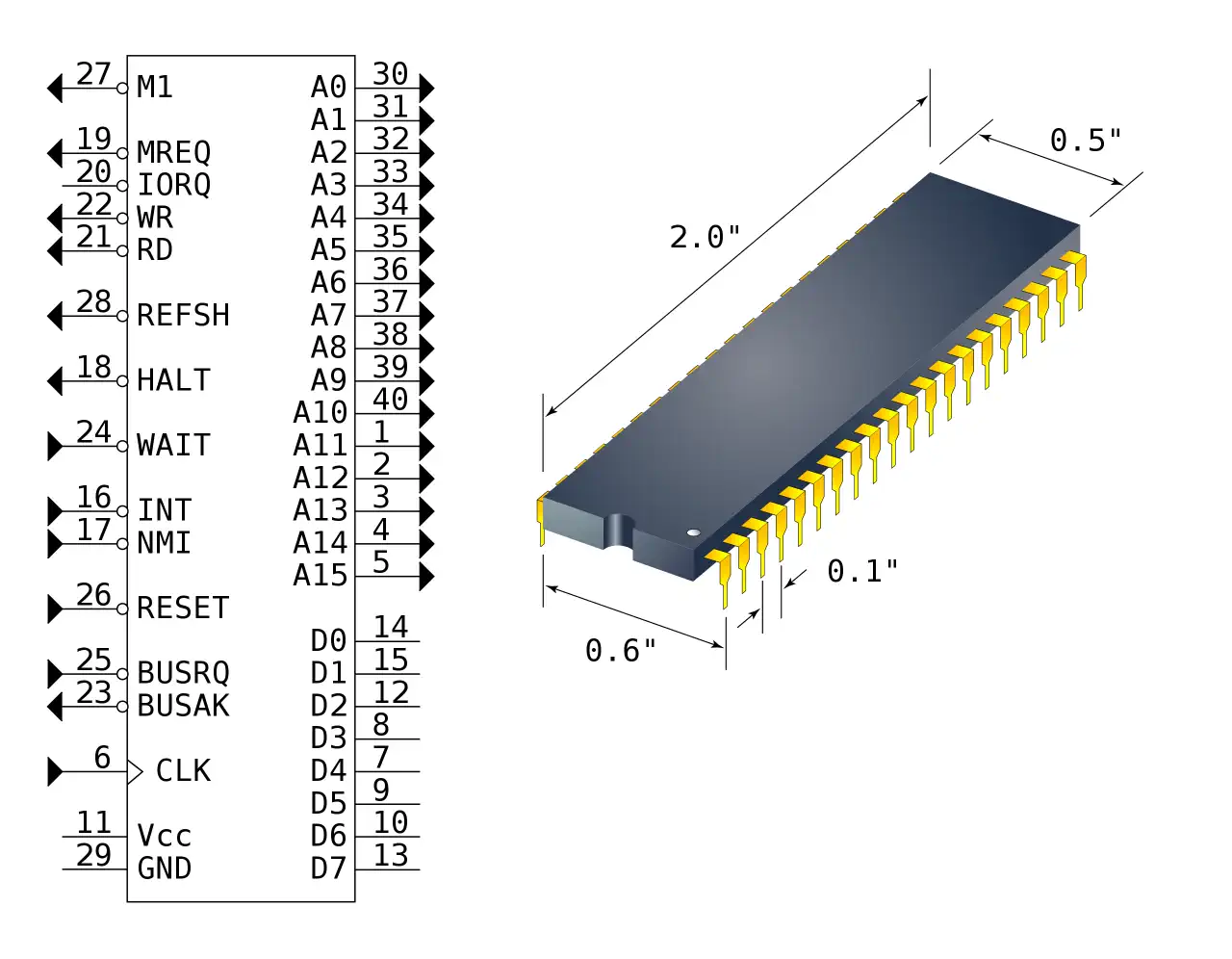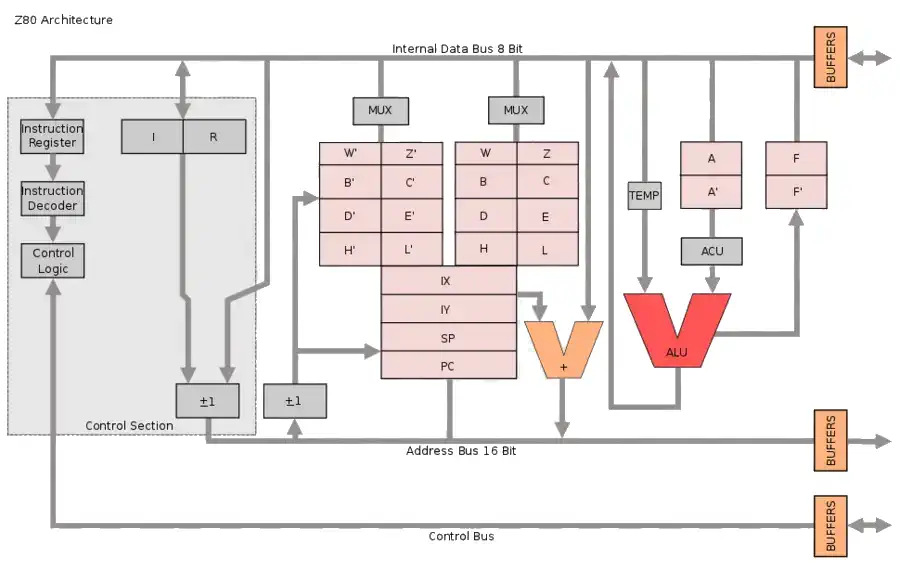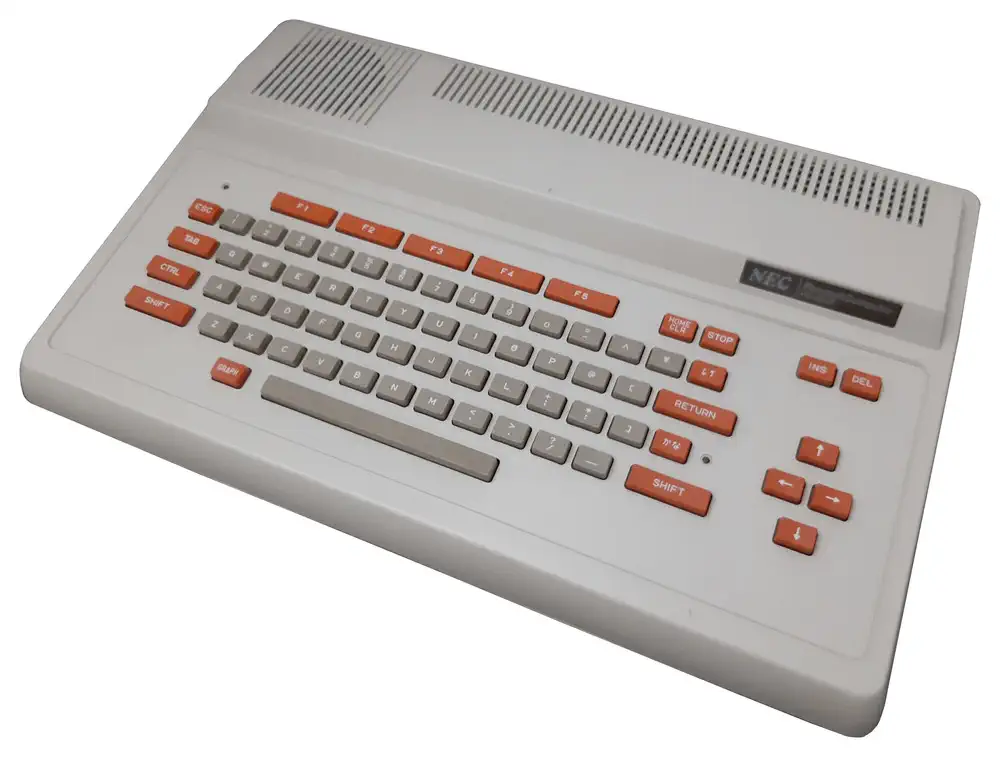NEC PC 6001 - NECs first PC
The NEC PC-6001 was released in Japan in 1981. It was introduced in the US at the Consumer Electronics Show in 1982. The computer came with a chiclet keyboard that was uncomfortable to type on. When it was released in the US in 1983, NEC had decided to upgrade the keyboard to a full-stroke typewriter keyboard. The US model was renamed to PC-6001A and was also known as the Nec TREK.
The machine had 16K of RAM, and used the uPD780C-1 Z80 compatible CPU running at 4MHz. The graphics were decent at 256x192 pixels in 9 colors. There was an expansion bus on the side of the computer, much like the TI-99's had. NEC sold the PC-6011A expansion unit that allowed the PC-6031 foloppy disk drive to be connected and provided three slots for ROM cartridges.
Programmable Sound Generator (AY-3-8910 compatible PSG)
The AY-3-8910 is a 3-voice Programmable Sound Generator, or PSG. It was designed by General Instruments in 1978 for use with their own 8-bit PIC1650 and their 16-bit CP1610 computers.
The PSG is widely used in many arcade cabinets, pinball machines, and many micro-computers. Here is a list of some of the major brands of computer that used the AY-3-8910:
- Intellivision
- Vectrex
- Amstrad CPC range
- Oric-1
- Color Genie
- Elektor TV Games Computer
- All MSX-1 and MSX-2 computers
- ZX Spectrum home computers
General Instrument spun of MicroChip Technology in 1987 and the chip was sold under the MicroChip brand, and licensed to Yamaha as the YM2149F which the Atari ST range of computers use. Functionally the PSG is very similar to the Texas Instruments SN76489.
Variants:
-
AY-3-8910
Comes with 2 general purpose 8-bit parallel I/O ports, used for Keyboard and Joystick in for instance MSX. -
AY-3-8912
Same chip, but in a 28-pin package. Parallel port B is not connected to save cost and space. -
AY-3-8913
Same chip, but in a 24-pin package. Both parallel ports are not connected. -
AY-3-8914
The AY-3-8914 has the same pinout and is in the same 40-pin package as the AY-3-8910, except the control registers on the chip are shuffled around, and the 'expected input' on the A9 pin may be different. It was used in Mattel's Intellivision console and Aquarius computer. -
AY-3-8930
Backwards compatible but BC2 pin is ignored
YM2149F -
YM3439-D
CMOS version of the Y2149 in 40-pin DIP -
YM3439-F
CMOS version of the Y2149 in 44-pin QFP -
YMZ294
Variant of the YM3249 in an 18-pin package. Parallel ports not connected, and all sound channels mixed on 1 port. -
T7766A
Toshiba variant of the AY-3-8910, fully compatible. Used in some MSX models. - Winbond WF19054, JFC95101, and File KC89C72: Fully compatible versions of the AY-3-8910 produced for slot machines.
Yamaha Produced chip, same pin-out as the AY-3-8910, but pin 26 could halve the master clock. Can be used to replace the AY-3-8910 if pin 26 is left disconnected.
Motorola MC6847 Video Display Generator
The MC6847 is a video display generator (VDG) first introduced by Motorola and used in the following machines (this is not a full list):
- TRS-80 Color Computer
- Dragon 32/64
- Laser 200
- TRS-80 MC-10/Matra Alice
- NEC PC-6000 series
- Acorn Atom
- APF Imagination Machine
The VDG is a relatively simple display generator compared to other display chips of the time. It is capable of displaying alphanumeric text, semigraphics and raster graphics contained within a roughly square display matrix 256 pixels wide by 192 lines high.
The ROM includes a 5 x 7 pixel font, compatible with 6-bit ASCII. Effects such as inverse video or colored text (green on dark green; orange on dark orange) are possible.
The MC6847 is capable of displaying nine colors:
- black
- green
- yellow
- blue
- red
- buff (almost-but-not-quite white)
- cyan
- magenta
- and orange

CPU View - Zilog Z80 Family
The Z80 quickly became popular in the personal computer market, with many early personal computers, such as the TRS-80 and Sinclair ZX80, using the Z80 as their central processing unit (CPU). It was also widely used in home computers, such as the MSX range, SORD, and the Amstrad CPC, as well as in many arcade games. Additionally, it was also used in other applications such as industrial control systems, and embedded systems. The Z80 was widely used until the mid-1980s, when it was gradually replaced by newer microprocessors such as the Intel 80286 and the Motorola 68000.
The Z80 microprocessor was developed by Zilog, a company founded by Federico Faggin in 1974. The Z80 was released in July 1976, as a successor to the Intel 8080. It was designed to be fully compatible with the 8080, but also included new features such as an improved instruction set, more powerful interrupts, and a more sophisticated memory management system.
The Z80 quickly became popular in the personal computer


RAM max: 48kB Sound Chip AY-3-8910A PSG Sound 3 Square Wave generators
1 noise generator
16 volume levels. Display Chip M5C6847P-1 video generator (MC6847 comp) Display 256x192 mono graphics, 128x192 in 9 colors Best Color 9 colors Graphics 256x192 monochrome Sprites none System OS N-BASIC Storage External Tape, External disk drives. Original Price #349

